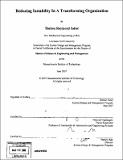Reducing instability in a transforming organization
Author(s)
Salter, Thelton Raymond
DownloadFull printable version (19.96Mb)
Other Contributors
System Design and Management Program.
Advisor
Deborah Nightingale.
Terms of use
Metadata
Show full item recordAbstract
It is obvious from many studies that an alignment and understanding around vision, strategy and goals must occur within a corporation across all organizations before the corporation can operate at its highest efficiency. This becomes even more important in a "flat" organization with distributed leaders. Having this type organization allows transformation to a lean enterprise because decisions can be made at a much lower level and therefore accomplished faster. However, the leaders must know and understand the corporate vision, strategy and organizational goals, which create the context and framework for many of the decisions that will need to be made. Absent this understanding, decisions can appear disjointed, uneven and without purpose towards meeting larger corporate goals and once made, the decision may not in fact support the corporate strategy. The results of this may manifest itself in internal instability caused by leadership vision changes.The Labor Aerospace Research Agenda (LARA) at MIT, starting in the late 1990's, has documented leadership vision changes as a major source of internal instability. This instability could be real or perceived but in either case if not properly managed could lead to a less efficient transformation. Thus, a structured approach around a common framework to create a shared vision from top to bottom throughout the corporation could prevent this instability from occurring. One corporation being studied has instituted a "roadmap" process, which was developed, in part, to address this issue. While the roadmap process does not address all stakeholders or potential sources of instability, it does address leadership vision and how that vision is turned into a strategy with shared goals. The purpose of this thesis is to: 1) Present an outline of the process used to align the corporation (cont.) 2) Present the results of whether there is a measurable difference in instability driven by changes in leadership vision between departments that use the "roadmap" process and those that don't 3) Compare the results from this company and others previously studied to determine if there is more or less internal instability naturally within the company 4) Conclude whether the roadmap process evaluated is beneficial or not and propose potential modifications to the process.
Description
Thesis (S.M.)--Massachusetts Institute of Technology, System Design and Management Program, 2007. Includes bibliographical references (p. 72).
Date issued
2007Department
System Design and Management Program.Publisher
Massachusetts Institute of Technology
Keywords
System Design and Management Program.